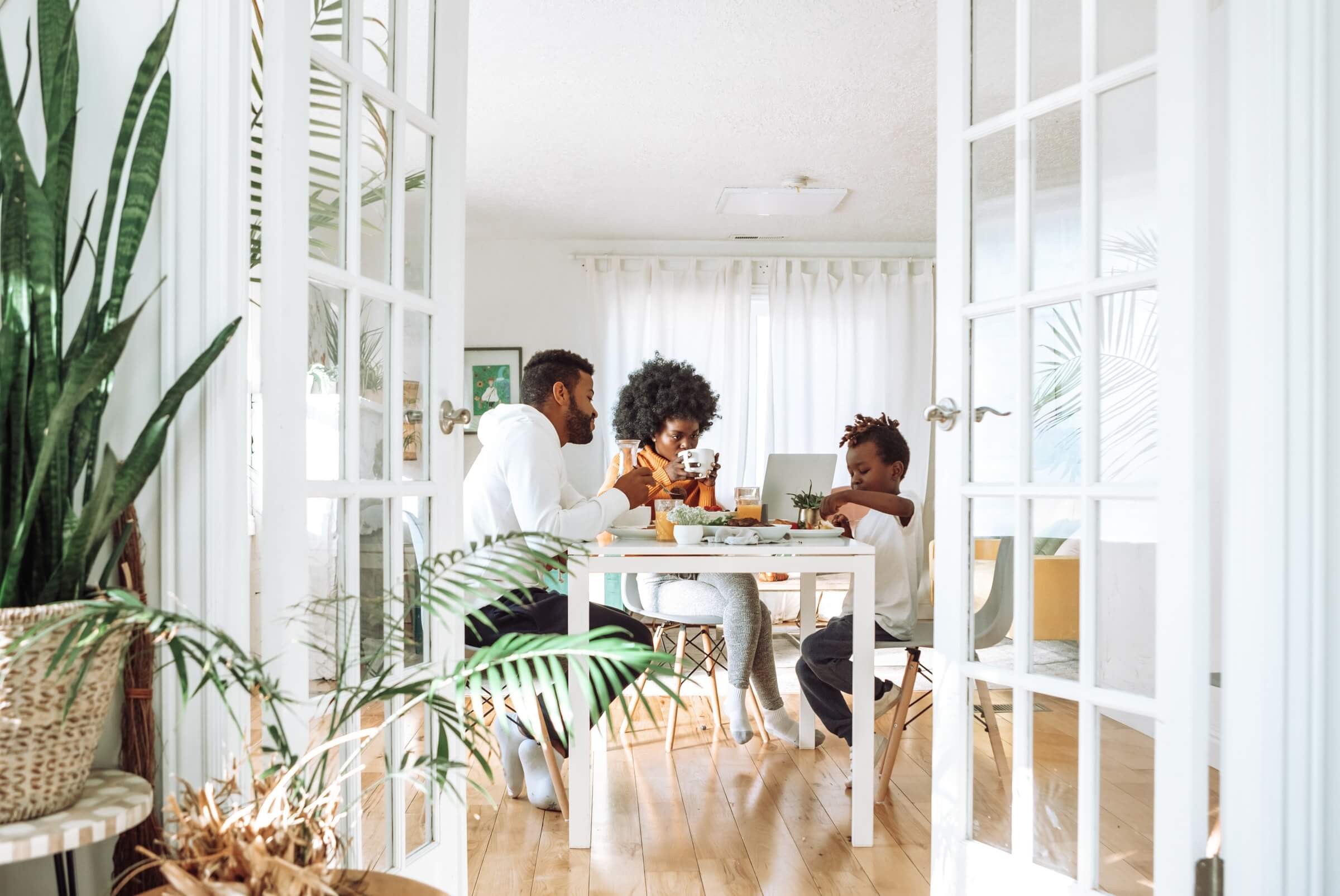Healthy habits create a healthy life. Likewise, healthy home habits create a healthy home. Part of those healthy home habits should aim to improve indoor air quality. Why? We know that our surrounding setting affects health and wellbeing, which makes ensuring a healthy and clean indoor environment absolutely crucial.
The idea of unknown indoor air pollutants circulating in your living spaces might sound scary. And the truth is—it can be quite scary. Indoor air pollution is a serious risk with serious potential consequences. It’s necessary to prioritize your home’s indoor air quality, particularly because indoor air pollution is inevitable in the modern world. Getting into the practice of healthy home habits can help!
How To Create a Healthy Home Environment
Why bother with creating a healthy home environment? It helps if you view the home as a possible source of sickness. After all, indoor spaces impact our physical, emotional, cognitive and respiratory health. That means your home is quite literally either benefitting or impairing your and your family’s health and wellness.
The good news is that it’s possible and easy to improve indoor air quality with healthy home habits. According to the National Center for Healthy Housing, a healthy home is one that is constructed, maintained and rehabilitated in a manner that is conducive to good occupant health. The maintained portion is what’s key for homeowners and renters alike.
Healthy indoor maintenance for good IAQ means ensuring dry, clean, well-ventilated, pollutant-free and pest-free spaces. Indoor air quality upgrades might be more difficult for those living in homes they don’t have complete control over like apartments, condos or shared buildings. But that’s the good secret to healthy home habits—they’re attainable for everyone.
Healthy Home Ideas
It’s easy to list the seemingly never-ending ways to worsen indoor air quality, but what can you do to improve it? Controlling the sources of indoor air pollution is a valuable first step. Also known as source control, actively minimizing pollution sources in the first place is the easiest way to boost air quality.
The essential part of healthy home practices is turning healthy home ideas into healthy home habits. It is crucial to practice these tips regularly and make them a routine part of your home life. Just like striving for a better sleep schedule or clean eating, striving for a healthier home means consistency is key. Plus, viewing them as habits makes them less of a chore and more like a health-conscious choice. Here are a handful of helpful habits for better home health and air quality!
1. Clean Regularly
Cleaning is an obvious home tip and important for many reasons. The advantages of cleaning for good indoor air quality should not be underestimated. Cleaning helps reduce the amount of dust, dander, allergens and other pollutants from circulating indoors. The best clean home practices to target IAQ are vacuuming regularly (particularly carpets and rugs) and routinely washing bedding, drapes and other linens. And of course—do not skip cleanings! A pro tip: run your home’s HVAC fan immediately after cleaning. This provides the chance for air now full of cleaning chemicals and the dust you couldn’t catch to pass through system filters.
 Indoor Living: Cleaning is a surprising indoor air pollution source. And yet cleaning is also necessary and helps improve indoor air quality. To bridge this conflict, we put together seven IAQ-friendly cleaning tips →
Indoor Living: Cleaning is a surprising indoor air pollution source. And yet cleaning is also necessary and helps improve indoor air quality. To bridge this conflict, we put together seven IAQ-friendly cleaning tips →2. Pass on Air Fresheners
While a refreshing smell seems helpful, air fresheners certainly are not. The aerosol sprays and plug-in spritzers actually worsen indoor air quality. Not only do they not remove pollutants or contaminants from the space, they aren’t actually removing odors either. They simply mask odors. It’s a temporary fix at best. As a result, air fresheners actually add particles to the air. This is a problem considering many air fresheners’ ingredient lists contain potentially hazardous chemicals.
3. Opt for Unscented Household Products
Similar to air fresheners, scented products often include harmful chemicals as ingredients. Sadly, that’s how the product smells good in the first place. This applies to cleaning products, candles, diffusers and more. The temporary fresh or fruity smell is not worth the threat of chemicals and VOCs. Choosing unscented and eco-friendly household products is a helpful habit to practice.
4. Groom Pets Regularly
Grooming pets might seem like an odd healthy home suggestion—but remember that pet dander is one of the top indoor allergens, and it probably makes more sense. Regularly grooming, brushing and washing pets is a helpful habit for good indoor air quality. Particularly for allergy sufferers who can’t quite give up their furry friends. Also make sure to regularly clean cages, tanks and litter boxes.
5. No Shoes Indoors
Wearing shoes inside is a common no-go for some and an afterthought for others. If you’re part of the latter group, we suggest getting into the habit of taking shoes off at the door. Shoes bring outside germs, bacteria, allergens and outdoor environmental pollutants into the home. Most likely you don’t want your home to be full of contaminants from the many places you frequent and the communal floors you’re walking on. Having a shoes off inside rule—and actually implementing it—can help.
6. Ventilate!
Ventilation is key. For numerous reasons. There are a few strategies available to improve home ventilation. Natural ventilation, or opening doors and windows, is the usual go-to. It is certainly necessary at times and can be beneficial, but it’s useful to get into the habit of checking outdoor air quality conditions before doing so. Spot ventilation is best thought of as localized ventilation. This looks like running the vent fan above the stove when cooking or running the fan in the bathroom when getting ready or showering—and an ideal habit to practice. (The final home ventilation fix is mechanical ventilation, but more on that upgrade later!)
7. Monitor Indoor Air Quality
Finally, monitoring your space’s indoor air quality is a decisive healthy home habit. Simply prioritizing and keeping track of indoor air quality leads to improvement. This is because once you start noticing the way your space’s air quality impacts your home and life, you’ll choose to take action. Monitoring can be as simple as noticing where throughout the home occupants have specific symptoms and what actions improve or worsen symptoms. It might mean charting to recognize how the change of seasons affects the space. Monitoring might also mean tracking pollutant levels, testing the HVAC system and literally monitoring home air quality with an in-duct air quality monitor.
In the end, monitoring indoor air quality is really the habit of being proactive. Indoor air pollution cannot and will not stop on its own. It requires intervention. And to properly intervene, you need to be aware of the air quality challenges in your home.
Healthy Home Upgrades
The alternative to healthy home habits and source control is indoor air quality solutions. Or, better yet, healthy home habits combined with whole-home IAQ control solutions. Also, if healthy home habits aren’t making enough of an improvement in your space, your home likely requires greater intervention. The next step is healthy home upgrades. IAQ solutions include ventilation, filtration, purification and humidity control. Pursuing one or any combination of IAQ control methods can drastically improve the health of your living spaces.
 Healthy Home IAQ Control Solutions: Learn more about all five IAQ control solutions, how they can benefit your indoor space, the system add-ons available and how they help control indoor air pollution →
Healthy Home IAQ Control Solutions: Learn more about all five IAQ control solutions, how they can benefit your indoor space, the system add-ons available and how they help control indoor air pollution →For example, humidity control is useful because the spread of indoor pollutants, such as biological contaminants, depends on indoor moisture to spread. Humidity regulation helps limit said growth. Or take air filters, which are your HVAC system’s top defense. A filter’s purpose is to trap and reduce contaminants from the air supply. So, clogged or dirty air filters mean the filter is doing its job, but it also means you should change air filters regularly. Even upgrading filtration to make sure your home air filter is as effective as possible. Purification and ventilation are whole-home solutions that benefit the entire HVAC system and space. Mechanical ventilation increases the amount of incoming filtered fresh air, improves circulation and dilutes indoor air pollution. Air purifiers sanitize both the air and surfaces in your space, further reducing pollutant levels.
Improved Indoor Air Quality
Whether you choose to pursue healthy home habits or healthy home upgrades (ideally both!) we assure you that choosing to actively intervene in your home will lead to better indoor air quality. And better indoor air quality means improved occupant health and home conditions. A combination of any of the aforementioned ideas helps to create a healthier indoor environment and maintain a healthy home.




